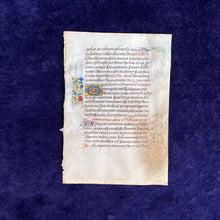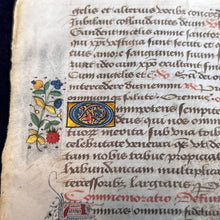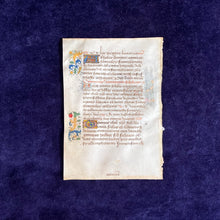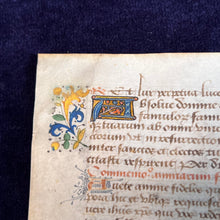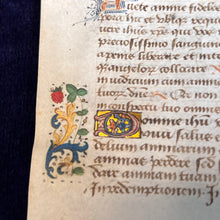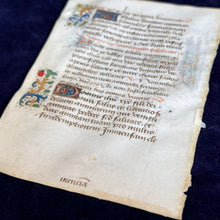
Low Countries, mid 15th century. (130 x 90 mm) Latin. 23 lines of Gothic Bâtarde. Three 2-line illuminated initials (one on recto, two on verso) with three partial borders with strawberry, acanthus, and ivy . Two 1-line rubricated initials with blue beading. Ruled lightly in pink. Catchword ([cle-] menciam) on bottom of verso. Spray of blue ink from illuminator on top fore-edge side of recto. Very visible hair and flesh-side (hair pattern evident). Includes text for Commemoratio Defuncorum and Commemoratio animarum fidelis, suggesting this was to be read on November 2nd.
The human touches of the Dutch hands that produced this book of hours, nearly 5 centuries ago, reach out across the many years and put themselves on display. The parchmentier, who prepared the vellum, was unable to eradicate the evidence that this medium was once an animal— the hair pattern forms a darkening on the fore-edge side of the recto, a reminder that this book is made of skin. If you look closely on the other side, you will notice that it is a creamy, uniform white: the flesh-side as its known. The illuminator has left a gentle spray of blue ink in the process of illuminating the O of omnipotents (all powerful). The illuminator would have come in after the scribe to add in the color—sometimes they were one and the same, but the process of writing then coloring was the same. We see that his goose-feathered quill (taken from the left wing to accomodate a right-handed scribe) left a small trail of ink, demonstrating human fallibility in a book to serve the worship of the infallible. In order for the stationer to put the book together once the ink had dried on the unfoliated pages, the scribe has written a catchword on the bottom of the verso. The stationer would have matched the end of the word “Cle- -mentia” with the next page, beginning with “-mentia” to make sure that the gatherings of folded vellum matched and were consecutive. The hand of the reader is missing— no marginal notations, no thumbprints from turning the pages— perhaps because of the luxurious nature of the book, it could have served as a display object rather than a functional guide to worship.






